EMR Error Detection via Ubiquitous Computing Synchronization Review
VerifiedAdded on 2024/06/28
|95
|11585
|330
Literature Review
AI Summary
This document presents a literature review focused on leveraging ubiquitous computing for efficient error detection in Electronic Medical Records (EMR). It analyzes five journal papers, examining various techniques, frameworks, and solutions. The review covers topics such as the ProFUSO framework for chronic patient management, cloud-based frameworks for traditional Chinese medical record retrieval, and the use of electronic patient records with mobile access. Each reviewed solution includes details on its goals, components, processes, advantages, limitations, validation criteria, and potential future work. The critical analysis highlights the features and limitations of each approach, assessing their value and applicability to EMR error detection and overall healthcare data management.

Literature Review (Secondary Research)
Student Name& CSU
ID
Project Topic Title Ubiquitous computing synchronization for efficient error detection in Electronic Medical Records (EMR)
1
Student Name& CSU
ID
Project Topic Title Ubiquitous computing synchronization for efficient error detection in Electronic Medical Records (EMR)
1
Paraphrase This Document
Need a fresh take? Get an instant paraphrase of this document with our AI Paraphraser
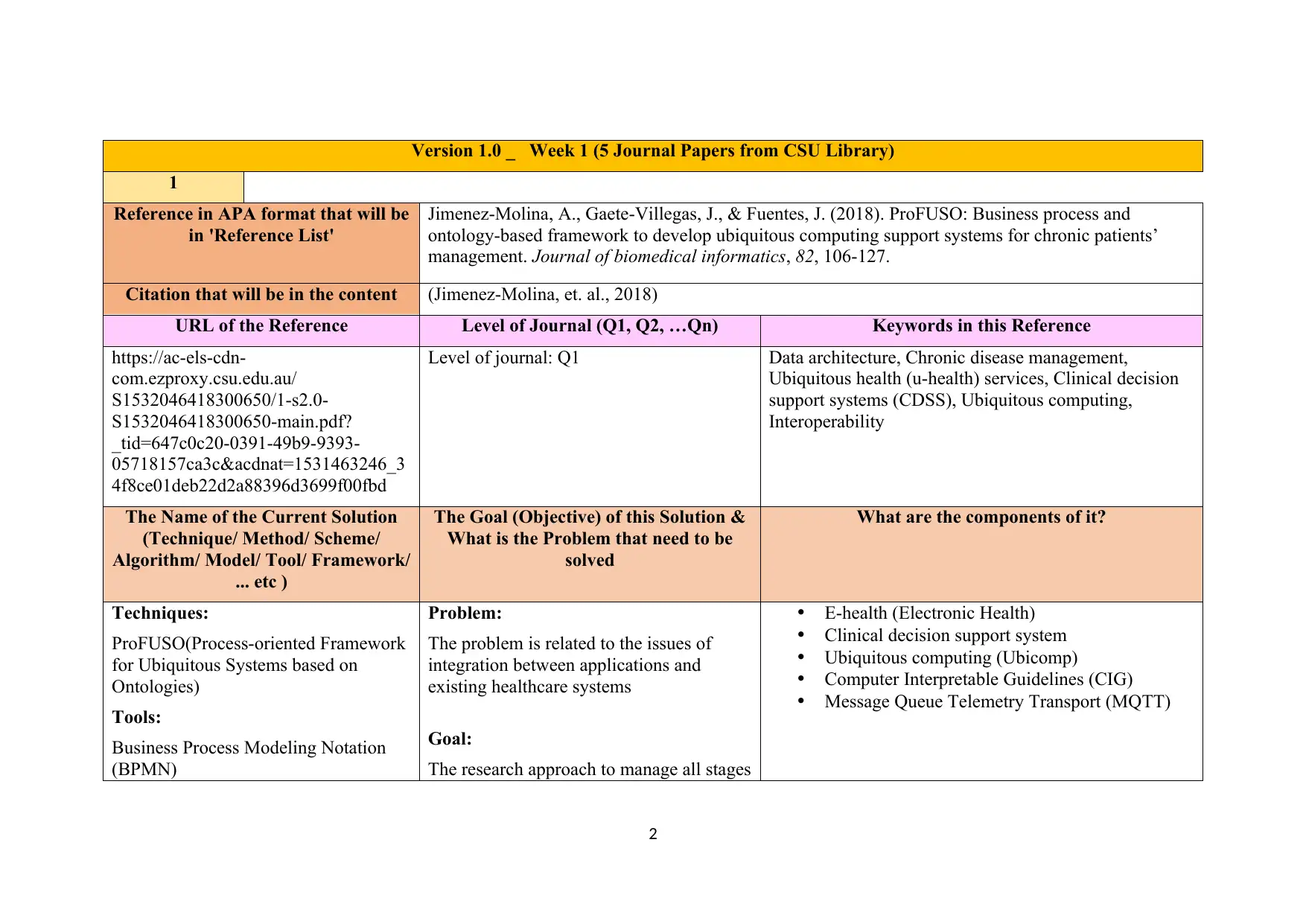
Version 1.0 _ Week 1 (5 Journal Papers from CSU Library)
1
Reference in APA format that will be
in 'Reference List'
Jimenez-Molina, A., Gaete-Villegas, J., & Fuentes, J. (2018). ProFUSO: Business process and
ontology-based framework to develop ubiquitous computing support systems for chronic patients’
management. Journal of biomedical informatics, 82, 106-127.
Citation that will be in the content (Jimenez-Molina, et. al., 2018)
URL of the Reference Level of Journal (Q1, Q2, …Qn) Keywords in this Reference
https://ac-els-cdn-
com.ezproxy.csu.edu.au/
S1532046418300650/1-s2.0-
S1532046418300650-main.pdf?
_tid=647c0c20-0391-49b9-9393-
05718157ca3c&acdnat=1531463246_3
4f8ce01deb22d2a88396d3699f00fbd
Level of journal: Q1 Data architecture, Chronic disease management,
Ubiquitous health (u-health) services, Clinical decision
support systems (CDSS), Ubiquitous computing,
Interoperability
The Name of the Current Solution
(Technique/ Method/ Scheme/
Algorithm/ Model/ Tool/ Framework/
... etc )
The Goal (Objective) of this Solution &
What is the Problem that need to be
solved
What are the components of it?
Techniques:
ProFUSO(Process-oriented Framework
for Ubiquitous Systems based on
Ontologies)
Tools:
Business Process Modeling Notation
(BPMN)
Problem:
The problem is related to the issues of
integration between applications and
existing healthcare systems
Goal:
The research approach to manage all stages
E-health (Electronic Health)
Clinical decision support system
Ubiquitous computing (Ubicomp)
Computer Interpretable Guidelines (CIG)
Message Queue Telemetry Transport (MQTT)
2
1
Reference in APA format that will be
in 'Reference List'
Jimenez-Molina, A., Gaete-Villegas, J., & Fuentes, J. (2018). ProFUSO: Business process and
ontology-based framework to develop ubiquitous computing support systems for chronic patients’
management. Journal of biomedical informatics, 82, 106-127.
Citation that will be in the content (Jimenez-Molina, et. al., 2018)
URL of the Reference Level of Journal (Q1, Q2, …Qn) Keywords in this Reference
https://ac-els-cdn-
com.ezproxy.csu.edu.au/
S1532046418300650/1-s2.0-
S1532046418300650-main.pdf?
_tid=647c0c20-0391-49b9-9393-
05718157ca3c&acdnat=1531463246_3
4f8ce01deb22d2a88396d3699f00fbd
Level of journal: Q1 Data architecture, Chronic disease management,
Ubiquitous health (u-health) services, Clinical decision
support systems (CDSS), Ubiquitous computing,
Interoperability
The Name of the Current Solution
(Technique/ Method/ Scheme/
Algorithm/ Model/ Tool/ Framework/
... etc )
The Goal (Objective) of this Solution &
What is the Problem that need to be
solved
What are the components of it?
Techniques:
ProFUSO(Process-oriented Framework
for Ubiquitous Systems based on
Ontologies)
Tools:
Business Process Modeling Notation
(BPMN)
Problem:
The problem is related to the issues of
integration between applications and
existing healthcare systems
Goal:
The research approach to manage all stages
E-health (Electronic Health)
Clinical decision support system
Ubiquitous computing (Ubicomp)
Computer Interpretable Guidelines (CIG)
Message Queue Telemetry Transport (MQTT)
2
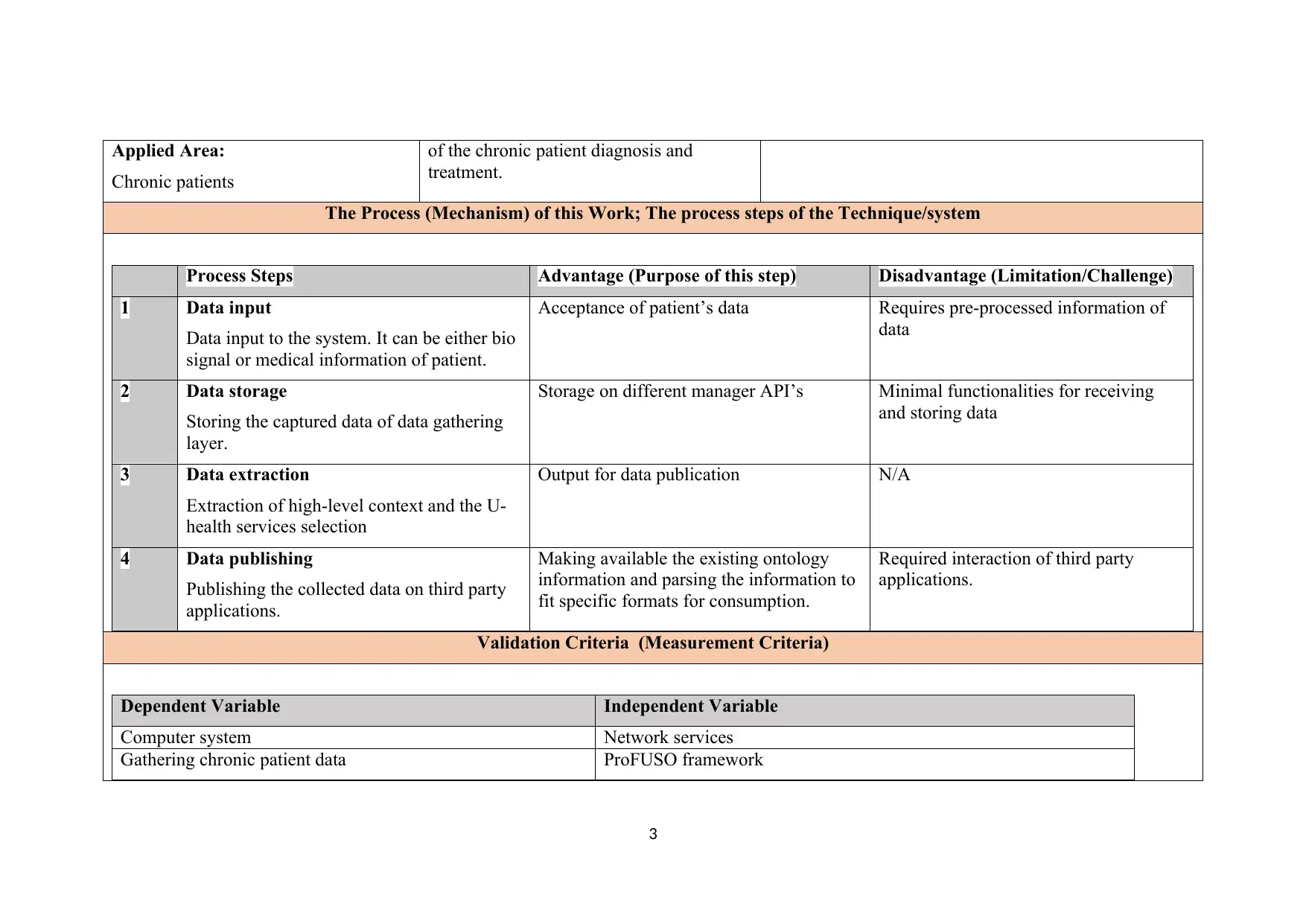
Applied Area:
Chronic patients
of the chronic patient diagnosis and
treatment.
The Process (Mechanism) of this Work; The process steps of the Technique/system
Process Steps Advantage (Purpose of this step) Disadvantage (Limitation/Challenge)
1 Data input
Data input to the system. It can be either bio
signal or medical information of patient.
Acceptance of patient’s data Requires pre-processed information of
data
2 Data storage
Storing the captured data of data gathering
layer.
Storage on different manager API’s Minimal functionalities for receiving
and storing data
3 Data extraction
Extraction of high-level context and the U-
health services selection
Output for data publication N/A
4 Data publishing
Publishing the collected data on third party
applications.
Making available the existing ontology
information and parsing the information to
fit specific formats for consumption.
Required interaction of third party
applications.
Validation Criteria (Measurement Criteria)
Dependent Variable Independent Variable
Computer system Network services
Gathering chronic patient data ProFUSO framework
3
Chronic patients
of the chronic patient diagnosis and
treatment.
The Process (Mechanism) of this Work; The process steps of the Technique/system
Process Steps Advantage (Purpose of this step) Disadvantage (Limitation/Challenge)
1 Data input
Data input to the system. It can be either bio
signal or medical information of patient.
Acceptance of patient’s data Requires pre-processed information of
data
2 Data storage
Storing the captured data of data gathering
layer.
Storage on different manager API’s Minimal functionalities for receiving
and storing data
3 Data extraction
Extraction of high-level context and the U-
health services selection
Output for data publication N/A
4 Data publishing
Publishing the collected data on third party
applications.
Making available the existing ontology
information and parsing the information to
fit specific formats for consumption.
Required interaction of third party
applications.
Validation Criteria (Measurement Criteria)
Dependent Variable Independent Variable
Computer system Network services
Gathering chronic patient data ProFUSO framework
3
⊘ This is a preview!⊘
Do you want full access?
Subscribe today to unlock all pages.

Trusted by 1+ million students worldwide
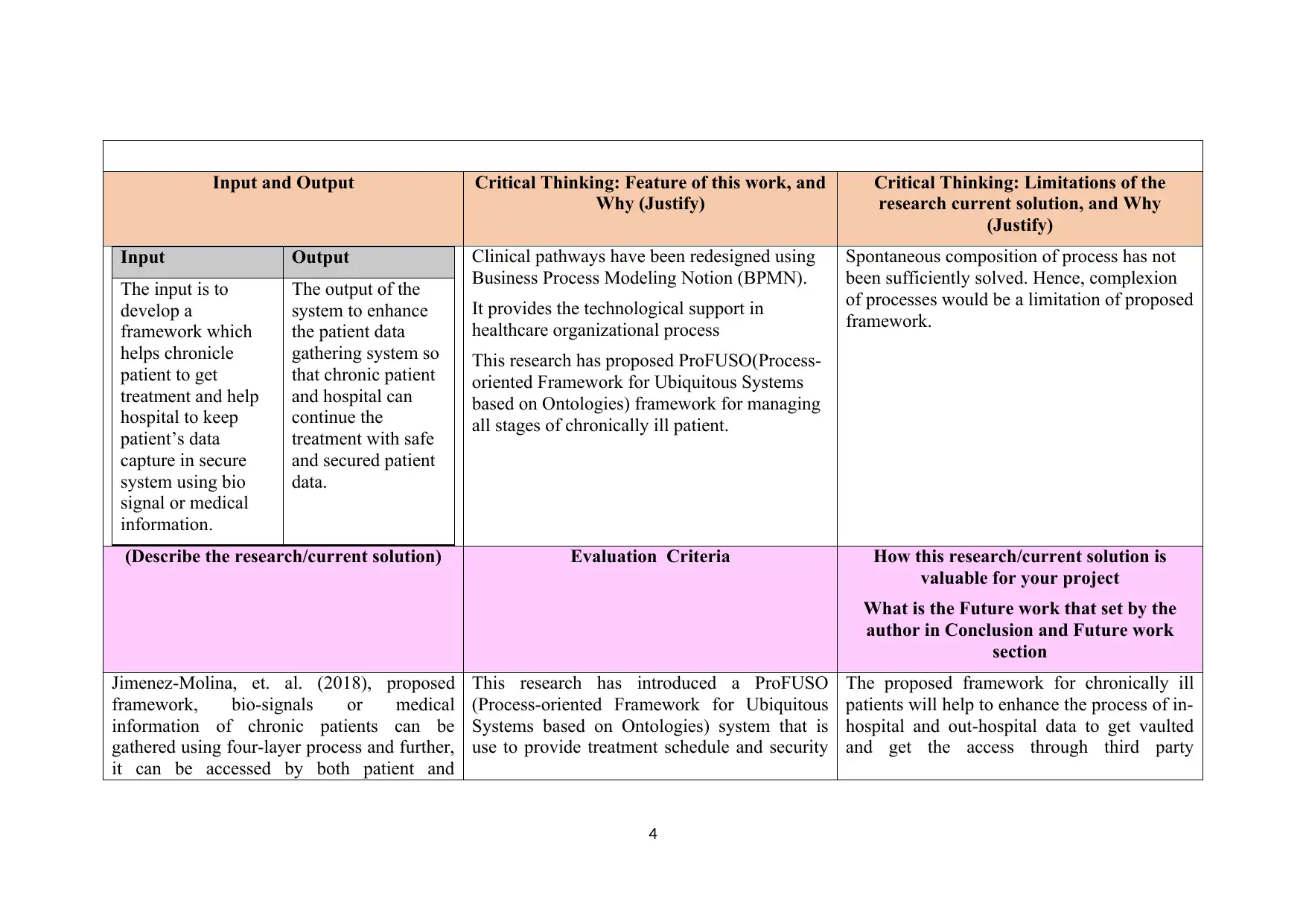
Input and Output Critical Thinking: Feature of this work, and
Why (Justify)
Critical Thinking: Limitations of the
research current solution, and Why
(Justify)
Input Output
The input is to
develop a
framework which
helps chronicle
patient to get
treatment and help
hospital to keep
patient’s data
capture in secure
system using bio
signal or medical
information.
The output of the
system to enhance
the patient data
gathering system so
that chronic patient
and hospital can
continue the
treatment with safe
and secured patient
data.
Clinical pathways have been redesigned using
Business Process Modeling Notion (BPMN).
It provides the technological support in
healthcare organizational process
This research has proposed ProFUSO(Process-
oriented Framework for Ubiquitous Systems
based on Ontologies) framework for managing
all stages of chronically ill patient.
Spontaneous composition of process has not
been sufficiently solved. Hence, complexion
of processes would be a limitation of proposed
framework.
(Describe the research/current solution) Evaluation Criteria How this research/current solution is
valuable for your project
What is the Future work that set by the
author in Conclusion and Future work
section
Jimenez-Molina, et. al. (2018), proposed
framework, bio-signals or medical
information of chronic patients can be
gathered using four-layer process and further,
it can be accessed by both patient and
This research has introduced a ProFUSO
(Process-oriented Framework for Ubiquitous
Systems based on Ontologies) system that is
use to provide treatment schedule and security
The proposed framework for chronically ill
patients will help to enhance the process of in-
hospital and out-hospital data to get vaulted
and get the access through third party
4
Why (Justify)
Critical Thinking: Limitations of the
research current solution, and Why
(Justify)
Input Output
The input is to
develop a
framework which
helps chronicle
patient to get
treatment and help
hospital to keep
patient’s data
capture in secure
system using bio
signal or medical
information.
The output of the
system to enhance
the patient data
gathering system so
that chronic patient
and hospital can
continue the
treatment with safe
and secured patient
data.
Clinical pathways have been redesigned using
Business Process Modeling Notion (BPMN).
It provides the technological support in
healthcare organizational process
This research has proposed ProFUSO(Process-
oriented Framework for Ubiquitous Systems
based on Ontologies) framework for managing
all stages of chronically ill patient.
Spontaneous composition of process has not
been sufficiently solved. Hence, complexion
of processes would be a limitation of proposed
framework.
(Describe the research/current solution) Evaluation Criteria How this research/current solution is
valuable for your project
What is the Future work that set by the
author in Conclusion and Future work
section
Jimenez-Molina, et. al. (2018), proposed
framework, bio-signals or medical
information of chronic patients can be
gathered using four-layer process and further,
it can be accessed by both patient and
This research has introduced a ProFUSO
(Process-oriented Framework for Ubiquitous
Systems based on Ontologies) system that is
use to provide treatment schedule and security
The proposed framework for chronically ill
patients will help to enhance the process of in-
hospital and out-hospital data to get vaulted
and get the access through third party
4
Paraphrase This Document
Need a fresh take? Get an instant paraphrase of this document with our AI Paraphraser
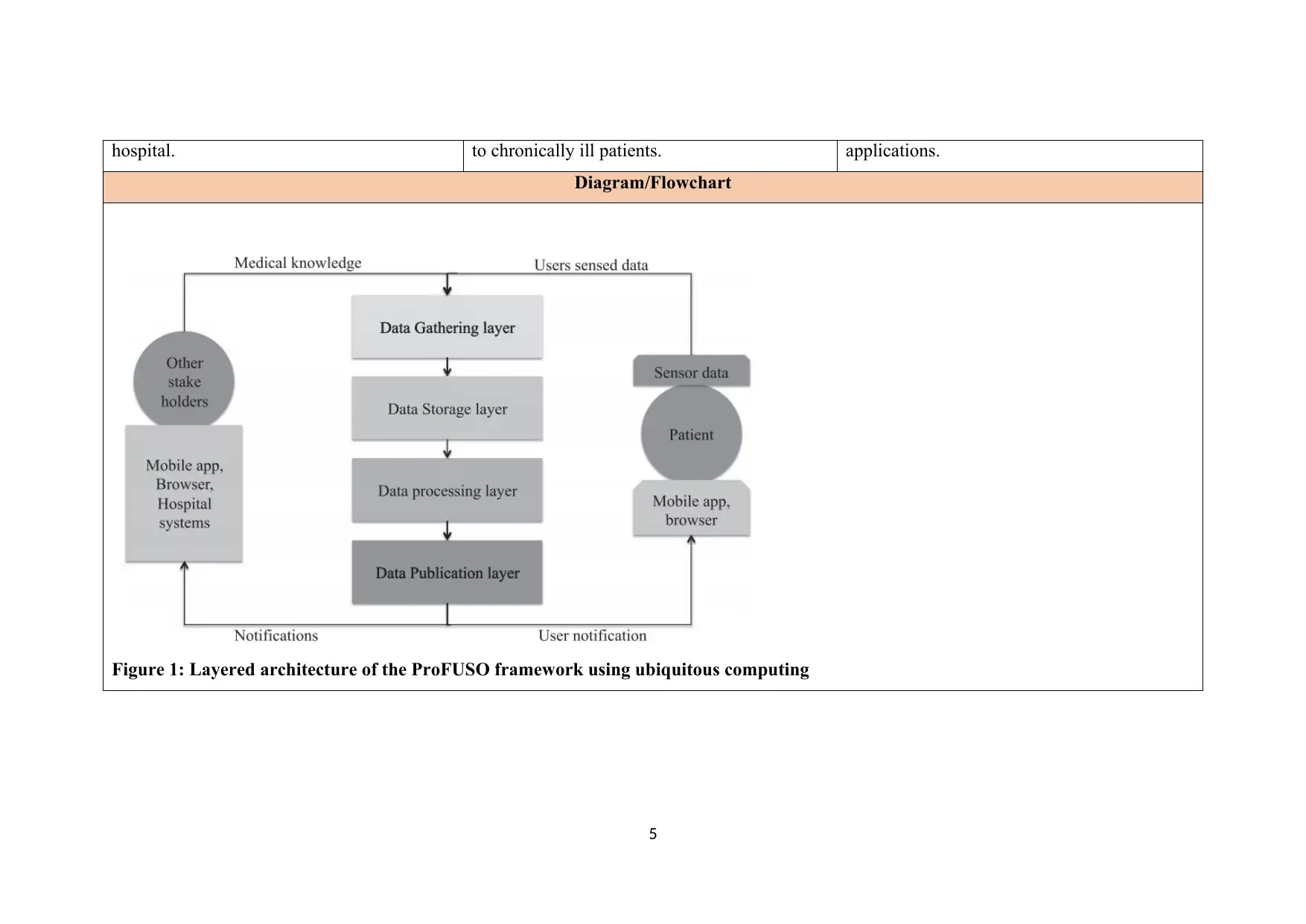
hospital. to chronically ill patients. applications.
Diagram/Flowchart
Figure 1: Layered architecture of the ProFUSO framework using ubiquitous computing
5
Diagram/Flowchart
Figure 1: Layered architecture of the ProFUSO framework using ubiquitous computing
5
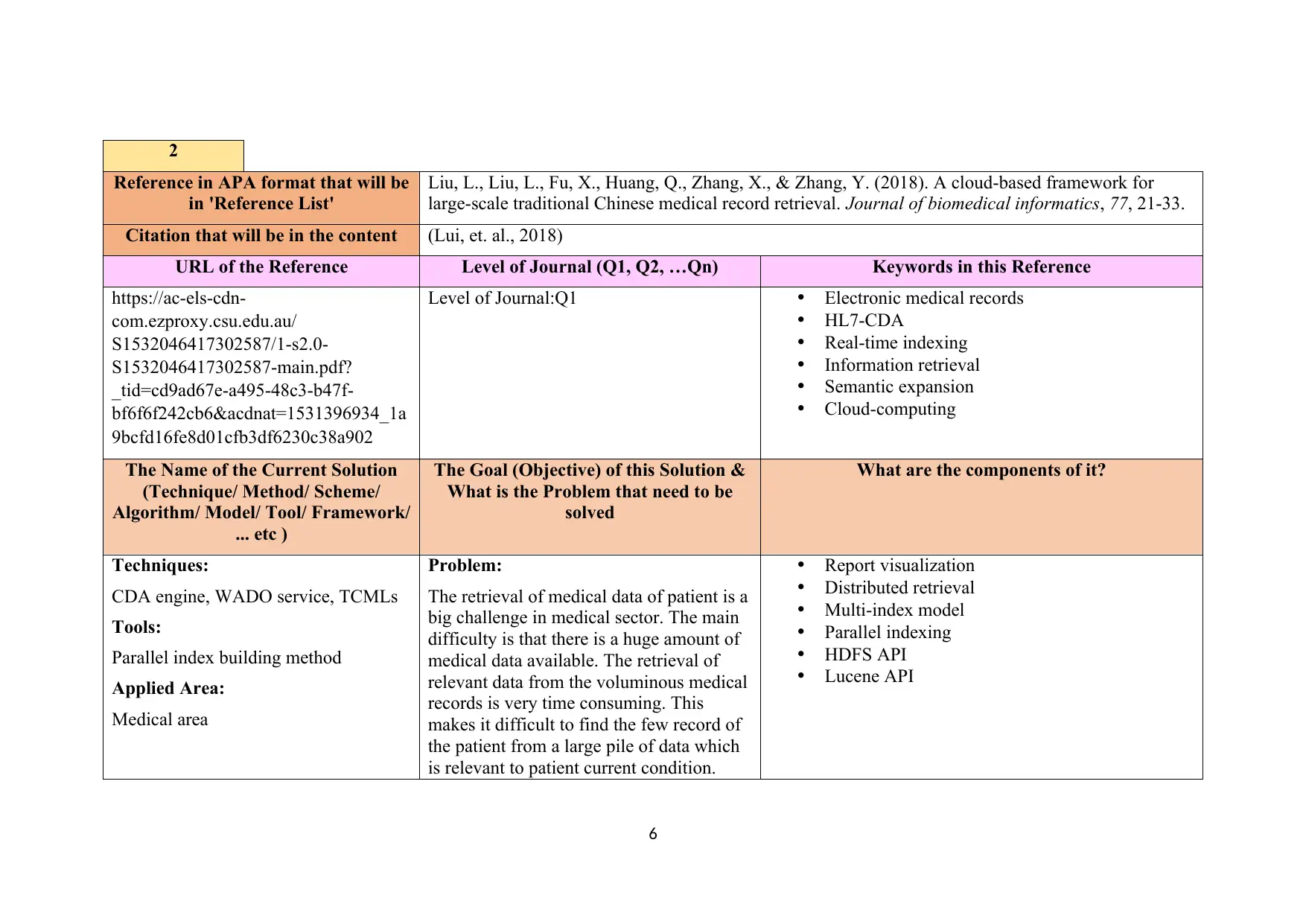
2
Reference in APA format that will be
in 'Reference List'
Liu, L., Liu, L., Fu, X., Huang, Q., Zhang, X., & Zhang, Y. (2018). A cloud-based framework for
large-scale traditional Chinese medical record retrieval. Journal of biomedical informatics, 77, 21-33.
Citation that will be in the content (Lui, et. al., 2018)
URL of the Reference Level of Journal (Q1, Q2, …Qn) Keywords in this Reference
https://ac-els-cdn-
com.ezproxy.csu.edu.au/
S1532046417302587/1-s2.0-
S1532046417302587-main.pdf?
_tid=cd9ad67e-a495-48c3-b47f-
bf6f6f242cb6&acdnat=1531396934_1a
9bcfd16fe8d01cfb3df6230c38a902
Level of Journal:Q1 Electronic medical records
HL7-CDA
Real-time indexing
Information retrieval
Semantic expansion
Cloud-computing
The Name of the Current Solution
(Technique/ Method/ Scheme/
Algorithm/ Model/ Tool/ Framework/
... etc )
The Goal (Objective) of this Solution &
What is the Problem that need to be
solved
What are the components of it?
Techniques:
CDA engine, WADO service, TCMLs
Tools:
Parallel index building method
Applied Area:
Medical area
Problem:
The retrieval of medical data of patient is a
big challenge in medical sector. The main
difficulty is that there is a huge amount of
medical data available. The retrieval of
relevant data from the voluminous medical
records is very time consuming. This
makes it difficult to find the few record of
the patient from a large pile of data which
is relevant to patient current condition.
Report visualization
Distributed retrieval
Multi-index model
Parallel indexing
HDFS API
Lucene API
6
Reference in APA format that will be
in 'Reference List'
Liu, L., Liu, L., Fu, X., Huang, Q., Zhang, X., & Zhang, Y. (2018). A cloud-based framework for
large-scale traditional Chinese medical record retrieval. Journal of biomedical informatics, 77, 21-33.
Citation that will be in the content (Lui, et. al., 2018)
URL of the Reference Level of Journal (Q1, Q2, …Qn) Keywords in this Reference
https://ac-els-cdn-
com.ezproxy.csu.edu.au/
S1532046417302587/1-s2.0-
S1532046417302587-main.pdf?
_tid=cd9ad67e-a495-48c3-b47f-
bf6f6f242cb6&acdnat=1531396934_1a
9bcfd16fe8d01cfb3df6230c38a902
Level of Journal:Q1 Electronic medical records
HL7-CDA
Real-time indexing
Information retrieval
Semantic expansion
Cloud-computing
The Name of the Current Solution
(Technique/ Method/ Scheme/
Algorithm/ Model/ Tool/ Framework/
... etc )
The Goal (Objective) of this Solution &
What is the Problem that need to be
solved
What are the components of it?
Techniques:
CDA engine, WADO service, TCMLs
Tools:
Parallel index building method
Applied Area:
Medical area
Problem:
The retrieval of medical data of patient is a
big challenge in medical sector. The main
difficulty is that there is a huge amount of
medical data available. The retrieval of
relevant data from the voluminous medical
records is very time consuming. This
makes it difficult to find the few record of
the patient from a large pile of data which
is relevant to patient current condition.
Report visualization
Distributed retrieval
Multi-index model
Parallel indexing
HDFS API
Lucene API
6
⊘ This is a preview!⊘
Do you want full access?
Subscribe today to unlock all pages.

Trusted by 1+ million students worldwide

Goal:
The goal is to develop a parallel indexing
method and building a distributed search
centre. This will make the searching the
patients file more efficiently and in less
time.
The Process (Mechanism) of this Work; The process steps of the Technique/system
Process Steps Advantage (Purpose of this step) Disadvantage (Limitation/Challenge)
1 Retrieval
Cloud based framework is used for
implementing the large scale TCMRs
retrieval system
It gives efficient and robust framework N/A
2 Cluster based processing
Parallel indexing and distributed search
cluster
It will be improve the performance of
indexing and will give high online retrieval
rate
N/A
3 Indexing
Multi indexing model is to be used
Help indexing the latest TCMRs and
retrieve them in real-time
It may not give the idea of actual utility
of returned document.
4 Expansion
Semantic expansion is used
It will enhance the quality of retrieved data N/A
5 Visualization
Template based visualization method is used
for increasing the ability of data.
It will enhance the usability and general
ability of the data
Designing and management of large
number of templates is difficult.
7
The goal is to develop a parallel indexing
method and building a distributed search
centre. This will make the searching the
patients file more efficiently and in less
time.
The Process (Mechanism) of this Work; The process steps of the Technique/system
Process Steps Advantage (Purpose of this step) Disadvantage (Limitation/Challenge)
1 Retrieval
Cloud based framework is used for
implementing the large scale TCMRs
retrieval system
It gives efficient and robust framework N/A
2 Cluster based processing
Parallel indexing and distributed search
cluster
It will be improve the performance of
indexing and will give high online retrieval
rate
N/A
3 Indexing
Multi indexing model is to be used
Help indexing the latest TCMRs and
retrieve them in real-time
It may not give the idea of actual utility
of returned document.
4 Expansion
Semantic expansion is used
It will enhance the quality of retrieved data N/A
5 Visualization
Template based visualization method is used
for increasing the ability of data.
It will enhance the usability and general
ability of the data
Designing and management of large
number of templates is difficult.
7
Paraphrase This Document
Need a fresh take? Get an instant paraphrase of this document with our AI Paraphraser

Validation Criteria (Measurement Criteria)
Dependent Variable Independent Variable
Merging and writing patient data CAD engine
Real time indexing of patient data WADO service
Input and Output Critical Thinking: Feature of this work, and
Why (Justify)
Critical Thinking: Limitations of the
research current solution, and Why
(Justify)
Input Output
The input in this
process is to
develop a model
that will make the
retrieval of medical
data of patients easy
and less time-
consuming. This
will provide the
required details of
the patient's current
condition out of all
un-necessary data.
The output in this
process is to
develop a
distributed TCMRs
retrieval system to
improve the use of
large scale of
TCMRs in cloud
computing. The
details of a patient
at the current
condition can be
fetched at higher
efficiency and in
very less time using
C-MRRS is implemented on a cloud
environment and medical records are
represent as
The technique uses template based
visualisation method which helps users to
display their content of medical report via
a friendly web interface.
In this role based and grade based mixed
security policies are used.
It is easily integrated with the exiting
clinical systems.
The main limitation in this model is that it
can only work on TCMRs only. It is very
difficult for this model to work on non-TCM
settings. Secondly, CDA templates are
designed and managed in a large number
which becomes very difficult. Third, This
model can give the idea of small term
matching but may not give the idea of actual
utility out of the returned documents. Lastly,
the effective feedback system is not present in
the model which makes it difficult to
understand user's intentions with the retrieved
data.
8
Dependent Variable Independent Variable
Merging and writing patient data CAD engine
Real time indexing of patient data WADO service
Input and Output Critical Thinking: Feature of this work, and
Why (Justify)
Critical Thinking: Limitations of the
research current solution, and Why
(Justify)
Input Output
The input in this
process is to
develop a model
that will make the
retrieval of medical
data of patients easy
and less time-
consuming. This
will provide the
required details of
the patient's current
condition out of all
un-necessary data.
The output in this
process is to
develop a
distributed TCMRs
retrieval system to
improve the use of
large scale of
TCMRs in cloud
computing. The
details of a patient
at the current
condition can be
fetched at higher
efficiency and in
very less time using
C-MRRS is implemented on a cloud
environment and medical records are
represent as
The technique uses template based
visualisation method which helps users to
display their content of medical report via
a friendly web interface.
In this role based and grade based mixed
security policies are used.
It is easily integrated with the exiting
clinical systems.
The main limitation in this model is that it
can only work on TCMRs only. It is very
difficult for this model to work on non-TCM
settings. Secondly, CDA templates are
designed and managed in a large number
which becomes very difficult. Third, This
model can give the idea of small term
matching but may not give the idea of actual
utility out of the returned documents. Lastly,
the effective feedback system is not present in
the model which makes it difficult to
understand user's intentions with the retrieved
data.
8
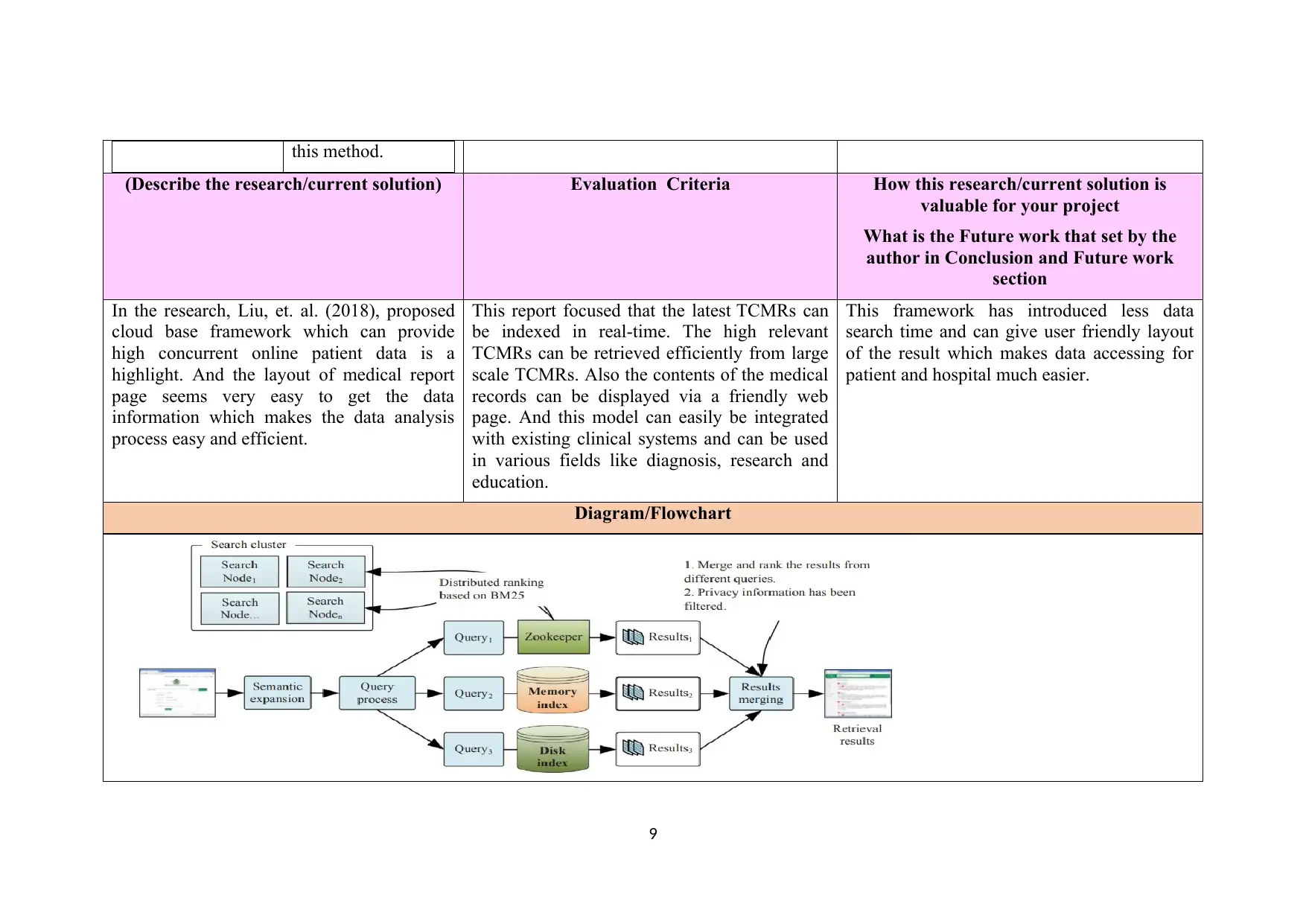
this method.
(Describe the research/current solution) Evaluation Criteria How this research/current solution is
valuable for your project
What is the Future work that set by the
author in Conclusion and Future work
section
In the research, Liu, et. al. (2018), proposed
cloud base framework which can provide
high concurrent online patient data is a
highlight. And the layout of medical report
page seems very easy to get the data
information which makes the data analysis
process easy and efficient.
This report focused that the latest TCMRs can
be indexed in real-time. The high relevant
TCMRs can be retrieved efficiently from large
scale TCMRs. Also the contents of the medical
records can be displayed via a friendly web
page. And this model can easily be integrated
with existing clinical systems and can be used
in various fields like diagnosis, research and
education.
This framework has introduced less data
search time and can give user friendly layout
of the result which makes data accessing for
patient and hospital much easier.
Diagram/Flowchart
9
(Describe the research/current solution) Evaluation Criteria How this research/current solution is
valuable for your project
What is the Future work that set by the
author in Conclusion and Future work
section
In the research, Liu, et. al. (2018), proposed
cloud base framework which can provide
high concurrent online patient data is a
highlight. And the layout of medical report
page seems very easy to get the data
information which makes the data analysis
process easy and efficient.
This report focused that the latest TCMRs can
be indexed in real-time. The high relevant
TCMRs can be retrieved efficiently from large
scale TCMRs. Also the contents of the medical
records can be displayed via a friendly web
page. And this model can easily be integrated
with existing clinical systems and can be used
in various fields like diagnosis, research and
education.
This framework has introduced less data
search time and can give user friendly layout
of the result which makes data accessing for
patient and hospital much easier.
Diagram/Flowchart
9
⊘ This is a preview!⊘
Do you want full access?
Subscribe today to unlock all pages.

Trusted by 1+ million students worldwide
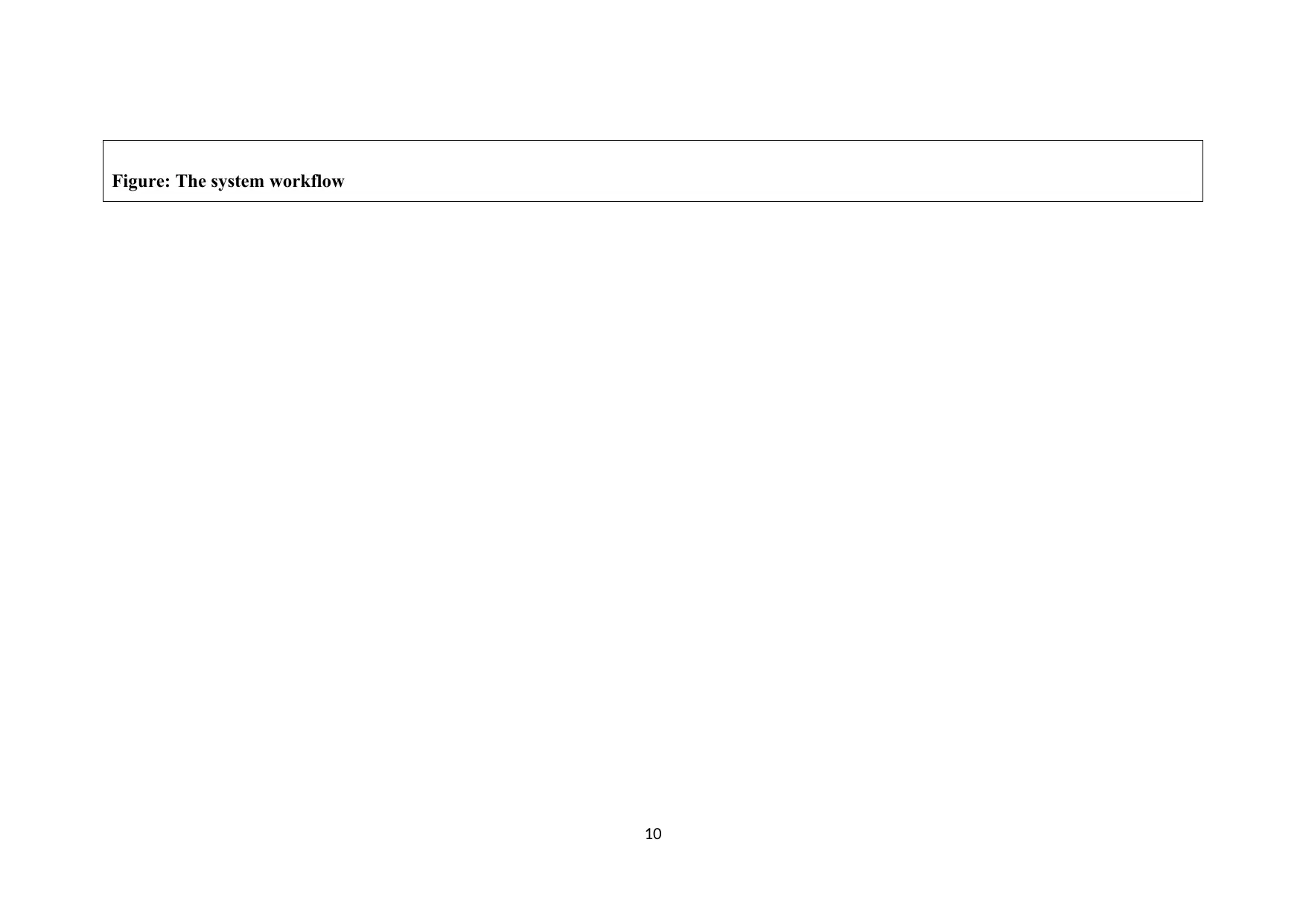
Figure: The system workflow
10
10
Paraphrase This Document
Need a fresh take? Get an instant paraphrase of this document with our AI Paraphraser
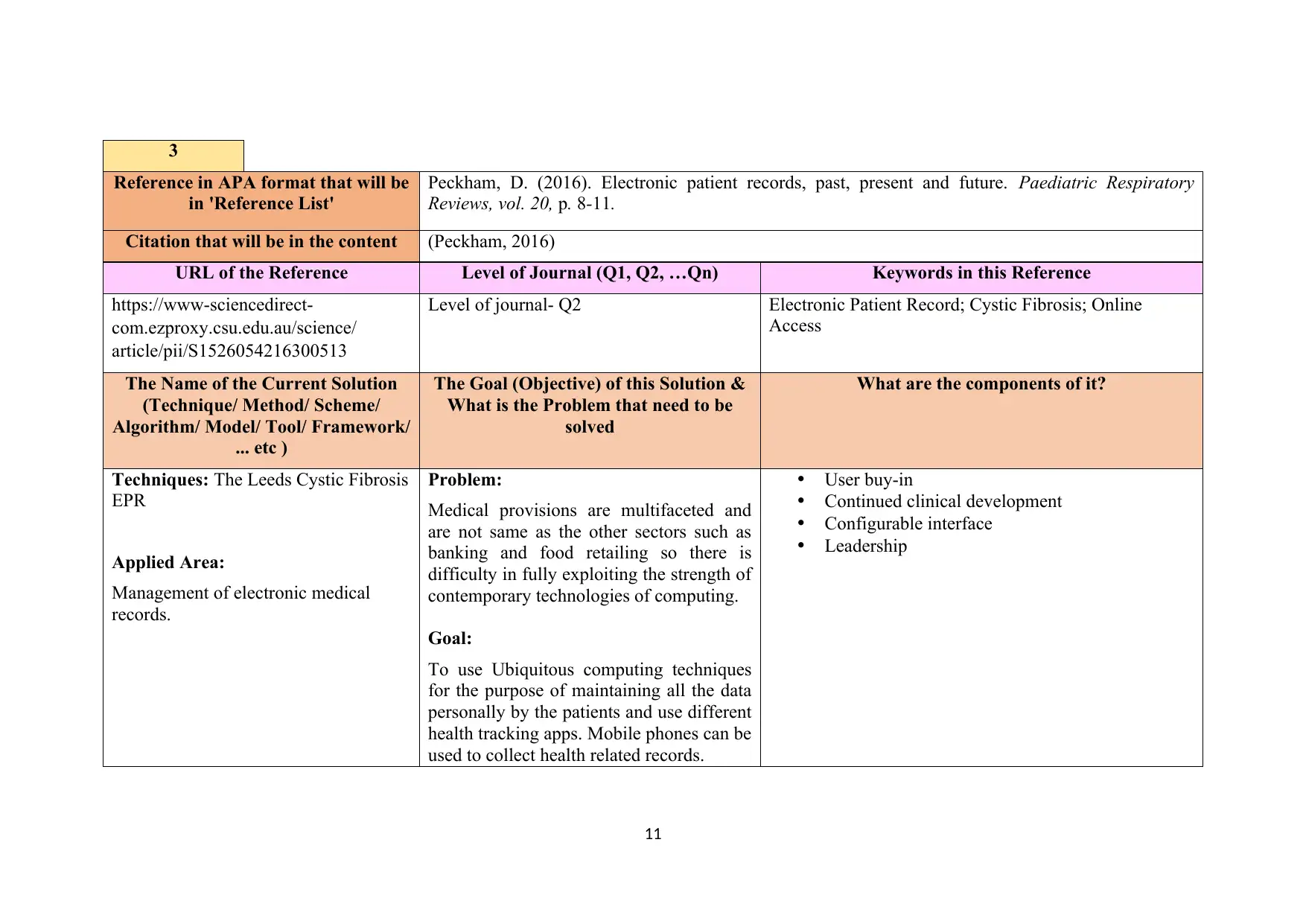
3
Reference in APA format that will be
in 'Reference List'
Peckham, D. (2016). Electronic patient records, past, present and future. Paediatric Respiratory
Reviews, vol. 20, p. 8-11.
Citation that will be in the content (Peckham, 2016)
URL of the Reference Level of Journal (Q1, Q2, …Qn) Keywords in this Reference
https://www-sciencedirect-
com.ezproxy.csu.edu.au/science/
article/pii/S1526054216300513
Level of journal- Q2 Electronic Patient Record; Cystic Fibrosis; Online
Access
The Name of the Current Solution
(Technique/ Method/ Scheme/
Algorithm/ Model/ Tool/ Framework/
... etc )
The Goal (Objective) of this Solution &
What is the Problem that need to be
solved
What are the components of it?
Techniques: The Leeds Cystic Fibrosis
EPR
Applied Area:
Management of electronic medical
records.
Problem:
Medical provisions are multifaceted and
are not same as the other sectors such as
banking and food retailing so there is
difficulty in fully exploiting the strength of
contemporary technologies of computing.
Goal:
To use Ubiquitous computing techniques
for the purpose of maintaining all the data
personally by the patients and use different
health tracking apps. Mobile phones can be
used to collect health related records.
User buy-in
Continued clinical development
Configurable interface
Leadership
11
Reference in APA format that will be
in 'Reference List'
Peckham, D. (2016). Electronic patient records, past, present and future. Paediatric Respiratory
Reviews, vol. 20, p. 8-11.
Citation that will be in the content (Peckham, 2016)
URL of the Reference Level of Journal (Q1, Q2, …Qn) Keywords in this Reference
https://www-sciencedirect-
com.ezproxy.csu.edu.au/science/
article/pii/S1526054216300513
Level of journal- Q2 Electronic Patient Record; Cystic Fibrosis; Online
Access
The Name of the Current Solution
(Technique/ Method/ Scheme/
Algorithm/ Model/ Tool/ Framework/
... etc )
The Goal (Objective) of this Solution &
What is the Problem that need to be
solved
What are the components of it?
Techniques: The Leeds Cystic Fibrosis
EPR
Applied Area:
Management of electronic medical
records.
Problem:
Medical provisions are multifaceted and
are not same as the other sectors such as
banking and food retailing so there is
difficulty in fully exploiting the strength of
contemporary technologies of computing.
Goal:
To use Ubiquitous computing techniques
for the purpose of maintaining all the data
personally by the patients and use different
health tracking apps. Mobile phones can be
used to collect health related records.
User buy-in
Continued clinical development
Configurable interface
Leadership
11

The Process (Mechanism) of this Work; The process steps of the Technique/system
Process Steps Advantage (Purpose of this step) Disadvantage (Limitation/Challenge)
1 Hospital portal: All physicians maintain all
the patients’ records on the hospital portal.
It provides facility of subscribing the
services.
Data leakage of mishandling can happen
at this stage.
2 Intelligent graphical interface: The system
uses the technique of intelligent graphical
interface.
Information is presented to both clinicians
and patients.
N/A
3 Access to records: all the records can be
personally accessed by patients on their
mobiles.
Easy access to their information. Increased responsibility on patients of
their own data.
Validation Criteria (Measurement Criteria)
Dependent Variable Independent Variable
Mobile systems Data storage
Hospital portal Information services
Computer systems Network services
Input and Output Critical Thinking: Feature of this work, and
Why (Justify)
Critical Thinking: Limitations of the
research current solution, and Why
12
Process Steps Advantage (Purpose of this step) Disadvantage (Limitation/Challenge)
1 Hospital portal: All physicians maintain all
the patients’ records on the hospital portal.
It provides facility of subscribing the
services.
Data leakage of mishandling can happen
at this stage.
2 Intelligent graphical interface: The system
uses the technique of intelligent graphical
interface.
Information is presented to both clinicians
and patients.
N/A
3 Access to records: all the records can be
personally accessed by patients on their
mobiles.
Easy access to their information. Increased responsibility on patients of
their own data.
Validation Criteria (Measurement Criteria)
Dependent Variable Independent Variable
Mobile systems Data storage
Hospital portal Information services
Computer systems Network services
Input and Output Critical Thinking: Feature of this work, and
Why (Justify)
Critical Thinking: Limitations of the
research current solution, and Why
12
⊘ This is a preview!⊘
Do you want full access?
Subscribe today to unlock all pages.

Trusted by 1+ million students worldwide
1 out of 95
Related Documents
Your All-in-One AI-Powered Toolkit for Academic Success.
+13062052269
info@desklib.com
Available 24*7 on WhatsApp / Email
![[object Object]](/_next/static/media/star-bottom.7253800d.svg)
Unlock your academic potential
Copyright © 2020–2025 A2Z Services. All Rights Reserved. Developed and managed by ZUCOL.




